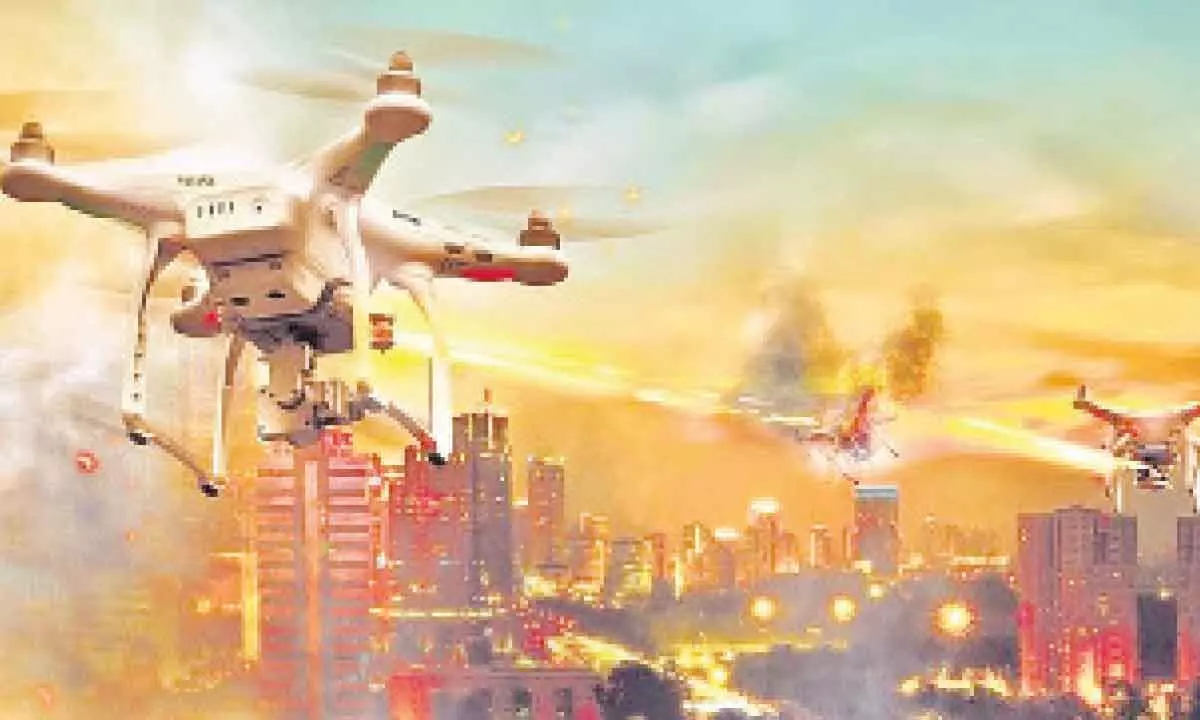Live
- They always want me to win, and now I feel lucky to have been offered a story like ‘Zebra’: Satyadev Kancharana
- ‘Democracy first, humanity first’: PM Modi in Guyana's parliament on two countries' similarities
- PKL Season 11: Telugu Titans register third straight win to top standings
- Is Pollution Contributing to Your COPD?
- NASA Unveils Underwater Robots for Exploring Jupiter's Moons
- Additional Central forces arrive in violence-hit Manipur
- AR Rahman and Saira Banu’s Divorce: Legal Insights into Common Issues in Bollywood Marriages
- 82.7 pc work completed in HPCL Rajasthan Refinery area: official
- Curfew relaxation extended in 5 Manipur districts on Friday
- Tab scam prompts Bengal govt to adopt caution over fund disbursement
Just In
No rules in the air: Drone dangers are real


Figuring out the national and international rules of the sky for drone usage is hard. For 20 years, experts have tried to create international agreements on arms – and some countries supported an informal 2016 UN agreement that recommends countries document the import and export of unmanned aerial vehicles. But these efforts never evolved into serious, comprehensive standards and laws that kept pace with technology
At least eight drone strikes hit Moscow in the early morning of May 30, 2023, damaging several buildings and injuring civilians. This follows Russia’s targeting residential buildings in Ukraine with a wave of drone attacks in late May, killing civilians.
While Ukraine has said it is not “directly” responsible for the strikes on Moscow, Russia’s government has called the strikes a “terrorist attack.” For more than a year, both Russia and Ukraine are using drones in this war to remotely locate targets and drop bombs, among other purposes.
Today, drones are used in various other conflicts but are also used to deliver packages, track weather and entertain drone hobbyists. Military drones range from small consumer quadcopters to remotely piloted warplanes – and all types are being used by militaries around the world.
It is important for people to understand drones and their proliferation, given the risks of war, terrorism and accidental drone clashes in the world today. A buying spree The US is among more than 100 countries using drones in times of conflict. Terrorists have also been known to deploy drones because they are relatively low-cost weapons with high degrees of civilian damage.
Consumer drone shipments, globally, topped 5 million units in 2020 and are expected to surpass 7 million by 2025. Sales of drones globally were up 57 per cent from 2021 to 2022.
China is increasingly using sophisticated drones for covert surveillance, especially in international waters to patrol the disputed islands in the South China Sea. Its expanding drone program has influenced other countries like the US to also invest more in the technology.
Turkey’s military has a highly sophisticated drone, the Bayraktar TB2, which is capable of carrying laser-guided bombs and small enough to fit in a flatbed truck. The United Arab Emirates imports drones from China and Turkey to deploy in Yemen and Libya to monitor warlords in case conflict breaks out. And South Korea is considering starting a special drone unit after it failed to respond to a recent North Korean drone incursion. When North Korea deployed five drones toward its southern neighbour in December 2022, South Korea had to scramble its fighter jets to issue warning shots.
International law prohibits the use of armed force unless the United Nations Security Council authorises an attack, or in the case of self-defence. But short of launching a full war, drones can legally be deployed for counterterrorism operations, surveillance and other non-self-defense needs, creating a slippery slope to military conflict.
Figuring out the national and international rules of the sky for drone usage is hard. For 20 years, experts have tried to create international agreements on arms – and some countries supported an informal 2016 UN agreement that recommends countries document the import and export of unmanned aerial vehicles. But these efforts never evolved into serious, comprehensive standards and laws that kept pace with technology.
In order protect their national sovereignty, governments do not want to release drone data. They also want to avoid duplication of their technology and to maintain their market share of the drone trade. US and drones The US has wrestled with how to balance drone warfare as it became involved in overseas operations in Iraq, Afghanistan, Syria and other conflict zones. The US killed a top al-Qaida leader with a drone strike in Afghanistan in 2022. But there have been other instances of drone strikes that resulted in unintended casualties and damage.
Drone dangers are real. Many drone experts believe it is unsafe for each country’s military to make its own decisions on drones with no rules guiding drone transfers, exports, imports and usage. Multiple drones can communicate with each other remotely, creating shared objectives rather than an individual drone path or pattern. Like a swarm of bees, these drones form a deadly and autonomous aerial army ripe for accidents.
With the advent of artificial intelligence and more sophisticated unmanned aerial vehicles, drones can change speed, altitude and targeting in seconds, making them even more difficult to track and investigate. Attacks can happen seemingly out of the blue.
Drone detection is another complication, especially on the battlefield. Ukrainian and Russian forces each want to know exactly where a drone originated. That can be difficult to determine, especially at night, as drones are fast-moving vehicles. Traditional radar detection has grown more sophisticated with new drone detection platforms to more accurately decipher the exact location of the drone operator. In my view, the world needs new and consistent rules on drone usage for the decade ahead – better international monitoring of drone incursions and more transparency in the outcome of drone attacks.
(The Conversation)

© 2024 Hyderabad Media House Limited/The Hans India. All rights reserved. Powered by hocalwire.com






